
Hurtigruten comes to my hometown Sortland, June 20, 3:30am. Midnight sun to the right.
I have come to the conclusion that I like my entertainment slow. I generally don’t watch TV, but the last few days I have been glued to the TV, watching the 8048-minute long live broadcast of Hurtigruten sailing from Bergen to Kirkenes, along the Norwegian coast. As you might expect, the show is very slow – we get to see the view from the ship, mixed in with interviews and commentaries onboard the ship, all in realtime. The TV station NRK2 shows everything live (and I get it through my cable TV here in Sweden), and a website shows the video stream with a good map and other information (more on the website below).
The show has been a big hit in Norway – some 1.3 million people (of Norway’s roughly 5 million people) watched the show Thursday and Friday, which are quite impressive numbers, and I expect the weekend ratings will be even higher. The hashtag #hurtigruten has been quite active on Twitter as well. I’m not surprised that people are watching the show, but it’s been even more interesting to see all the people that show up along the coast, waving from land, cruising around in boats, and also the huge crowds at all the stops. The small places are generally the ones with the most people. My hometown Sortland (with 10,000 inhabitants), for instance, had more people show up at 3:30 at night than Trondheim (with 175,000 people) had in the middle of day. It seems like the experience of the show took people somewhat by surprise – the premise sounds quite ludicrous, like watching paint dry on live TV, but people took a look out of pure curiosity and then found it hard to stop. Twitter is full of people who seemed unable to turn off the TV and go to bed at night as Hurtigruten sailed through Vesterålen in the midnight sun.
I think there are many reasons why the Hurtigruten show stuck a chord in Norway. One of them has to do with history and nature. The infrastructural role of Hurtigruten as a critical means of transportation is long past. Once upon a time it was essential for bringing people, mail, and goods in a reliable way along the coast. It still brings cargo and people, of course, but today there are many other options available. Like many old technologies, Hurtigruten has found new life in new roles. More than anything else, Hurtigruten is a tourist ship now. But I think the show also demonstrates that Hurtigruten has become a part of the cultural landscape of coastal Norway and a way of experiencing and taking part in nature.
What can we say about this new genre of travel TV? Is it really a form of Baudrillardian simulacra, of mediated consumer culture imitating the real world? What is the relationship between the experience of being aboard Hurtigruten, experiencing nature first-hand, and watching it on TV? Right now I think of it as a form of augmented reality, a communal experience that adds to the physical experience. It may be mediated, but there is also something profound and tremendously powerful at work here (I hesitate to call it authentic, but perhaps I should).
The Hurtigruten show is a fantastic experience, culturally immersive and able to bring the entire country together in a way that few other TV programs have. But it is important to note that it is without the instant gratification of so much contemporary entertainment. In a way, it can be compared to the slow food movement. It is slow entertainment, meant to be stretched out and savored. In fact, I have seen several comment that NRK should go even slower, take out the interviews and documentaries, and just stick with the slowly changing landscapes as the ship progresses along the coast. I agree wholeheartedly.
Digital technologies and mediated environments
Now, in order to justify watching this show at work (and then taking the time to write a blog post about it) I want to highlight some possible lessons for environmental historians, digital humanists, and others in academia.

The last year I have been thinking much about the intersections between environmental history and the digital humanities. In what ways can digital technologies help us think about and analyze historical environments in new ways? How can we understand the new forms of storytelling that arise around mapping technologies (which I briefly blogged about before)? I’m involved in large a collaborative project between Umeå University and Stanford University project called Media Places, where we wish to explore the notion of mediated places in a broad sense. I want to use this project as a platform to look at the creation and mediation of natural sites and environments, and the Hurtigruten show seems to me a good example of this.
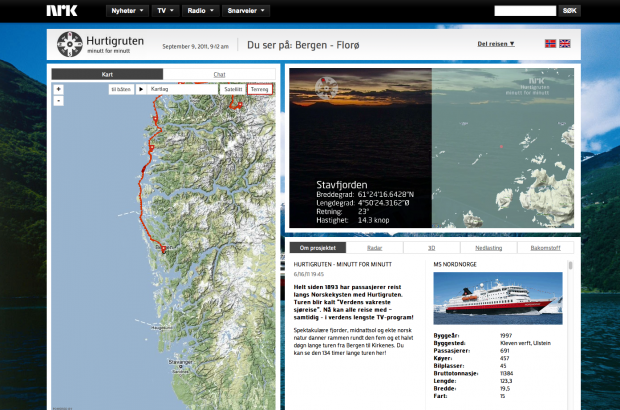
I think the website that NRK made for the show represents a great model for visualizing travel. As we see above, the site has three main elements: 1) a zoomable map with a red line marking the progress of Hurtigruten and markers for all the stops along the way. 2) a video window showing a live or archived video stream. Clicking anywhere along the red line on the map will show you the video for that spot. 3) a info window that shows you information about Hurtigruten, radar data, links to torrent downloads of raw video data in full HD (CC-licensed), and a link to a 3D view in Google Earth.
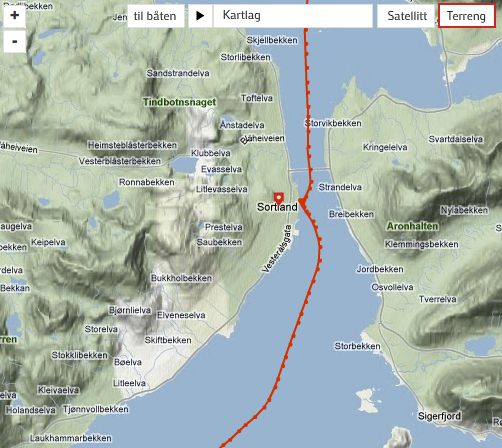
Using Google Maps, NRK has created a nice interface for following a journey in time and space. Two years ago I presented a paper at the American Society for Environmental History conference where I attempted to recreate the strenuous and time-consuming journey from Bergen to the Vøringsfossen waterfall in the late 1800s, one of the big, scenic tourist attractions at the time. If I had more experience with the Google Maps API I could probably create a website that would trace this journey and visualize it. Using layers, I could compare the route and speed for different points in time, such as 1900, 1950, and 2000, to get a feeling of the changing experience of space and distance. I think we have much to do in exploring other forms of narratives, of presenting and analyzing environmental history.
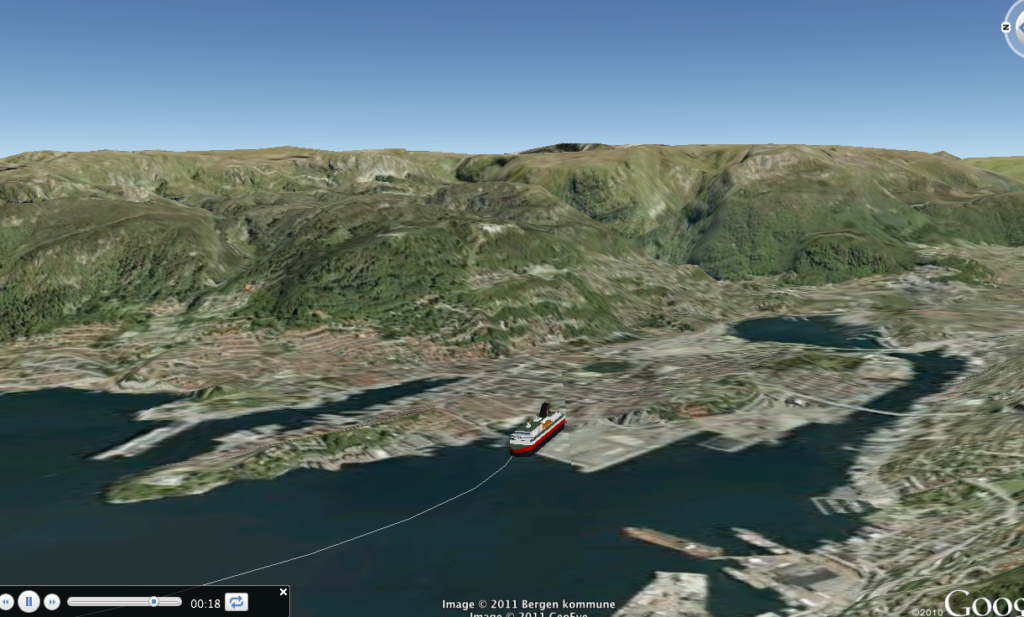
On the fringes of commercial services
We have several examples of similar experiments in mapping and storytelling. First, we have the predecessor to the Hurtigruten show, when NRK followed the Bergensbanen railroad from Oslo to Bergen, in realtime. After the show, NRK released a torrent with a 246 GB HD file (!), or a compressed 720p file at 22GB (which is still big enough to make things complicated) and encouraged mashups. 1.2 million Norwegians watched parts of the show, which was later released as a DVD.
Second, Google also made a railroad visualization, in a slightly different way, for the Transsiberian Railroad from Moscow to Vladivostok {no longer functioning}.
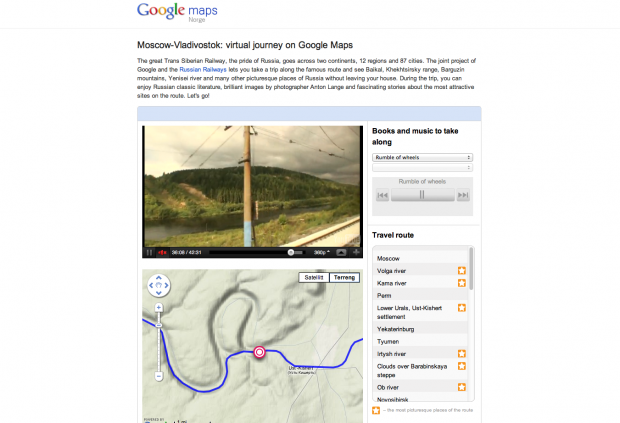
Third, many may know Google and NORAD’s Santa Tracker, which tracks Santa flying across the globe at Christmas.
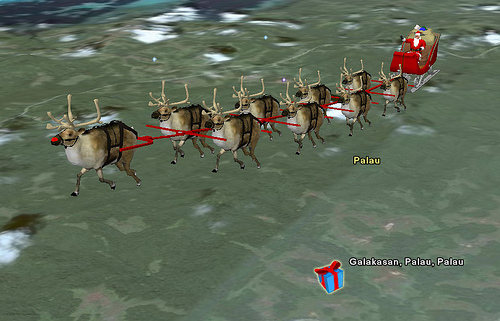
I think we are going to see many more such forays into hybrid narratives, using maps, video, text, and social networking. I am excited to see that public and commercial companies like NRK and Google exploring crazy ideas like the Hurtigruten show, that does not seem to have any immediate commercial appeal. And I’m curious to see how we in academia can learn from and refine what they are doing.